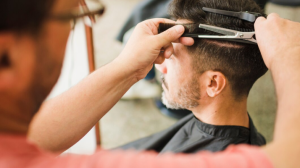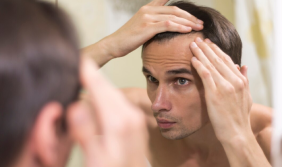Finasteride & Minoxidil: The Most Effective Hair Loss Combo?
Among all the hair loss treatments available, two options stand out: minoxidil and finasteride. But what sets them apart, and can they be used together? Let’s compare finasteride and minoxidil.
While there are important differences between the two, there’s no need to choose one over the other — in fact, using them together can be even more effective in treating hair loss than using either alone.
Below, we’ll explain how finasteride and minoxidil work, review the research behind them, and examine their potential side effects. We’ll also cover how to combine these treatments to prevent hair thinning and promote regrowth for a thicker, fuller head of hair.
How Minoxidil and Finasteride Work
Dealing with hair loss can be challenging, especially if you’re among the many men experiencing male pattern baldness. Fortunately, there are effective treatment options available. Minoxidil (found in Rogaine®) and finasteride (found in Propecia®) have been extensively researched and proven to slow down hair loss.
Both oral finasteride and topical minoxidil are approved by the FDA for treating male androgenetic alopecia, also known as male pattern baldness. Although there are other forms of these medications, such as topical finasteride and oral minoxidil, they are not yet FDA-approved for hair loss treatment. This doesn’t mean they are unsafe; they just haven’t gone through the complete FDA approval process.
Let’s take a closer look at how these two medications work and the differences between them.
How Minoxidil Works
Minoxidil was originally developed to treat high blood pressure in its oral form, but it was soon discovered to promote hair growth as a side effect. Today, it is available as a topical treatment in both foam and liquid solutions, applied directly to the scalp.
Minoxidil works as a vasodilator, which means it widens blood vessels and increases circulation to the hair follicles, stimulating hair growth. It helps lengthen the anagen phase (the growth phase) of the hair cycle and shifts resting hairs into this phase, promoting new hair growth. Typically, results can be seen after about eight weeks of consistent use.

How Finasteride Works
Finasteride, or Propecia®, is an oral medication that inhibits the conversion of testosterone into dihydrotestosterone (DHT), a hormone that causes hair follicles to shrink. By reducing DHT levels, finasteride helps prevent further hair loss and supports the regrowth of hair. It is commonly prescribed in 1mg doses for hair loss treatment.
Men with higher sensitivity to DHT or genetically predisposed to higher DHT levels are more likely to experience male pattern baldness. Finasteride effectively lowers DHT levels, which can stop the progression of hair loss and even reverse it in some cases.
Minoxidil vs. Finasteride: How They Compare
Minoxidil acts like a fertilizer for your hair, providing the necessary nutrients for growth, while finasteride works as a shield, protecting hair follicles from DHT damage. They target hair loss from different angles, making them complementary treatments.
Side Effects of Minoxidil and Finasteride
Both medications are generally safe but can cause side effects. Minoxidil may lead to skin irritation, dryness, and temporary shedding as the hair adjusts to the growth cycle. Finasteride, especially in its oral form, can have side effects such as decreased libido, erectile dysfunction, and changes in ejaculatory volume.
Combining Minoxidil and Finasteride
Using minoxidil and finasteride together has been shown to be more effective than using either treatment alone. They work in different ways, so combining them can enhance overall hair growth and retention. This combination is considered safe and is often recommended by healthcare professionals for those seeking optimal results.
Choosing Between Minoxidil and Finasteride
If your hair loss is mild, you might start with minoxidil, which is available over the counter. For more significant hair loss, finasteride or a combination of both may be more effective. Discussing your options with a healthcare professional can help you determine the best treatment plan for your specific needs.
The Bottom Line
Minoxidil and finasteride are both powerful tools in the fight against hair loss. When used together, they can offer even better results. Whether you choose one or both, starting treatment sooner rather than later is key to preserving your hair and achieving the best possible outcome.






